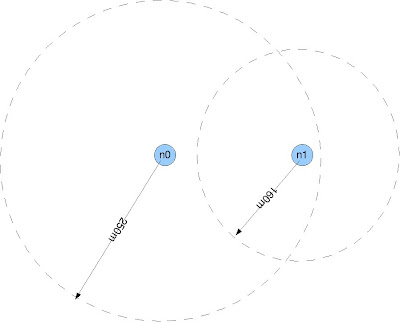Most of my online friends asked me that "is any way to increase transmission range of nodes in one simulation??".Here, we are showing a simple scenario and test sample script for this.
Scenario:
Two wireless nodes n0 and n1 are placed into a flat area and have distance of 200m. Both nodes send packets with the same transmission power, but have different receiving range. I set n0's receiving range to 250m, and its carrier sensing range to 550m. n1's receiving range is 160m, and its carrier sensing range is 400m.
EXPLANATION OF RESULT:
Both nodes try to send exactly one packet to the other using DSR. Because there is no bi-directional connection exist, the actual data connection could not be be established (DSR needs a bi-directional connection for route discovery). However, we can verify the difference of two transmission ranges by observing the reachability of DSR RREQ packets broadcast by each node.
The first connection starts at the 1st second, from n0 to n1. The second connection starts at the 5th second, from n1 to n0. By analyzing the trace file, I found that the all RREQ packets from n0 were not heard by n1. But all RREQ packets sent by n1 were successfully received by n0. This makes sense because n1's receiving ranges (160m) is samller than its distance to n0 (200m), thus it cannot heard any packet from n0. However, because n0's receiving range (250m) is bigger than the distance, it can hear RREQ from n1. n0 also sent out replies to n1, but n1 could not heard it.
For sample TCL Script, Click here
Scenario:
Two wireless nodes n0 and n1 are placed into a flat area and have distance of 200m. Both nodes send packets with the same transmission power, but have different receiving range. I set n0's receiving range to 250m, and its carrier sensing range to 550m. n1's receiving range is 160m, and its carrier sensing range is 400m.
Both nodes try to send exactly one packet to the other using DSR. Because there is no bi-directional connection exist, the actual data connection could not be be established (DSR needs a bi-directional connection for route discovery). However, we can verify the difference of two transmission ranges by observing the reachability of DSR RREQ packets broadcast by each node.
The first connection starts at the 1st second, from n0 to n1. The second connection starts at the 5th second, from n1 to n0. By analyzing the trace file, I found that the all RREQ packets from n0 were not heard by n1. But all RREQ packets sent by n1 were successfully received by n0. This makes sense because n1's receiving ranges (160m) is samller than its distance to n0 (200m), thus it cannot heard any packet from n0. However, because n0's receiving range (250m) is bigger than the distance, it can hear RREQ from n1. n0 also sent out replies to n1, but n1 could not heard it.
For sample TCL Script, Click here

thank you mean while can you help me in heterogeneous multihop network
ReplyDelete